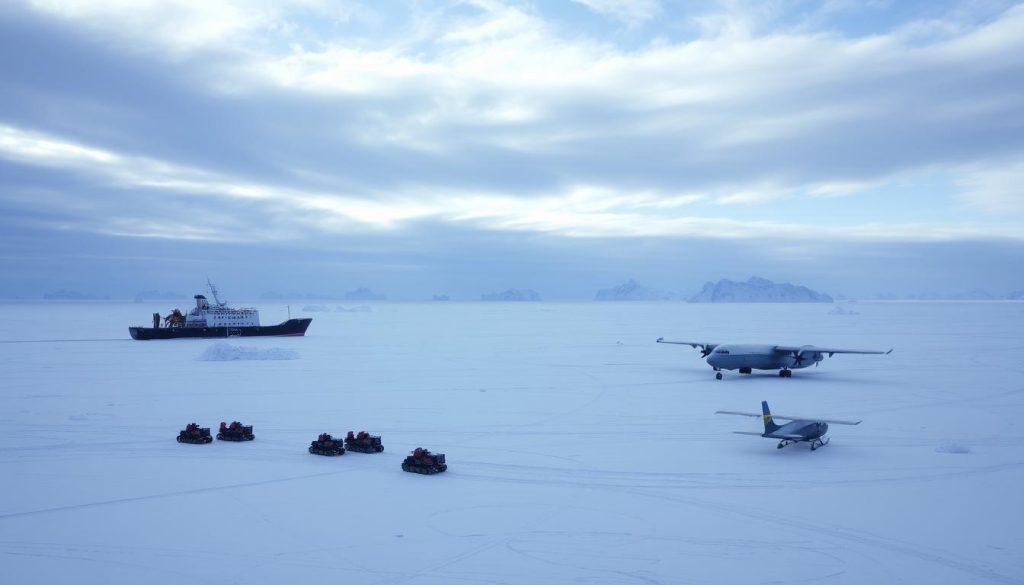Starting a transport business in Antarctica offers a chance to work in a unique place. This area is important for science, tourism, and basic transport needs. It shows why reliable transport services are needed in Antarctica. If you plan to start this business, it’s essential to know about the area and what the market needs. This part will talk about what helps a transport business do well in Antarctica. It will prepare you for more details on special tactics and things to think about.
The Unique Landscape of Antarctica

Antarctica’s geography is all about its vast ice sheets. They cover almost 98% of the continent. This makes it one of the planet’s most unique places. The landscape boasts huge glaciers, deep crevasses, and big icebergs. Each of these features makes travel very challenging. Not just stunning, the Antarctic landscape is also quite dangerous. Sudden weather changes are always a possibility.
Antarctica is known for its extreme weather. Blizzards and white-outs can happen suddenly. This makes it hard to see and navigate. The wind chill can make temperatures drop to very cold levels. This means people need special gear and training to stay safe. These tough conditions show why careful planning is so critical for transportation.
The geography of Antarctica makes transporting things very hard. There aren’t many roads or transport links like in other places. Moving goods and people around needs creative solutions. These solutions must work with the changing icy ground. This highlights how important it is to know about Antarctica’s unique landscape.
Understanding the Legal Framework
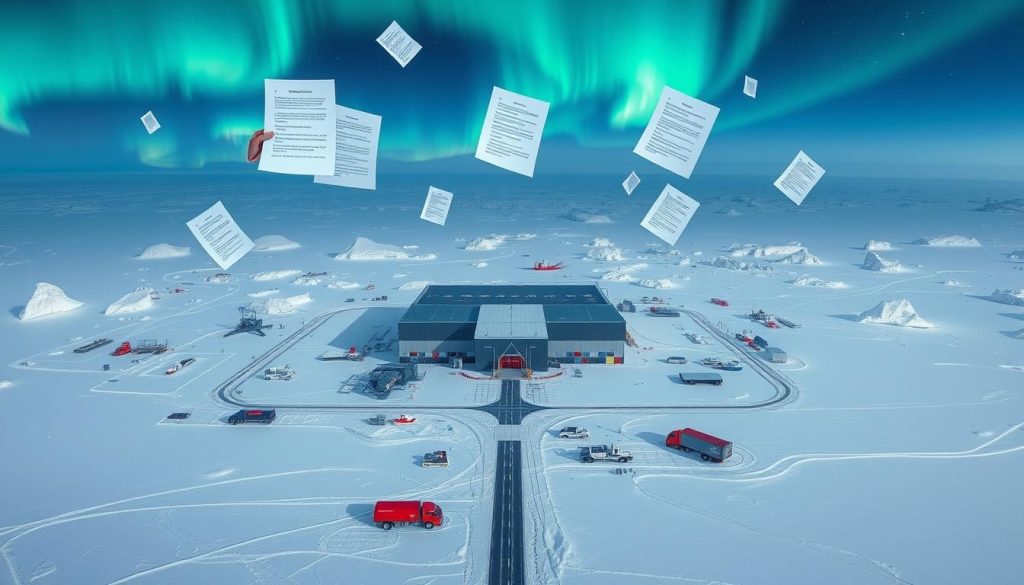
The Antarctic legal framework is complicated, guided mainly by the Antarctic Treaty System. This system includes the Antarctic Treaty, the Protocol on Environmental Protection, and other agreements. These agreements set rules focusing on protecting the environment and encouraging countries to work together peacefully. For businesses wanting to work in Antarctica, knowing these treaties is very important.
Business owners must follow specific rules when transporting goods in Antarctica. These rules help protect the area’s delicate ecosystem. To follow these rules, businesses need to get the correct permits and follow certain safety measures. If they don’t, they could face big fines and their operations could be interrupted.
Businesses that understand and follow the Antarctic legal rules can operate responsibly. They help to look after this special place by sticking to these treaties. This way, businesses play a part in keeping Antarctica’s environment safe.
How to Start a Transportation Business in Antarctica

Starting a transportation business in Antarctica needs deep knowledge of the market and logistics. To begin, one should look into the needs arising from tourism, research trips, and support for science teams. A thorough transport needs analysis will unveil the specific services needed by different groups in this untouched area.
Assessing Market Demand
The need for transport in Antarctica changes with the seasons, driven by tourism and research. A good market study can shed light on the most sought-after transport services. Important steps include:
- Finding out when more tourists come
- Looking at how often and what kind of research missions happen
- Understanding the kind of logistical support science expeditions need
Knowing current trends helps businesses position themselves well to offer needed transport services.
Identifying Key Logistics Challenges
Logistics in Antarctica face unique challenges. These include:
- Managing distant bases
- Dealing with changing weather that affects schedules
- Facing supply chain issues due to hard-to-reach locations
To tackle these challenges, careful planning and new ideas are vital. Studying successful businesses in this field provides valuable insights. This helps new business owners create strong strategies for thriving in such a tough setting.
Types of Transportation Services in Antarctica
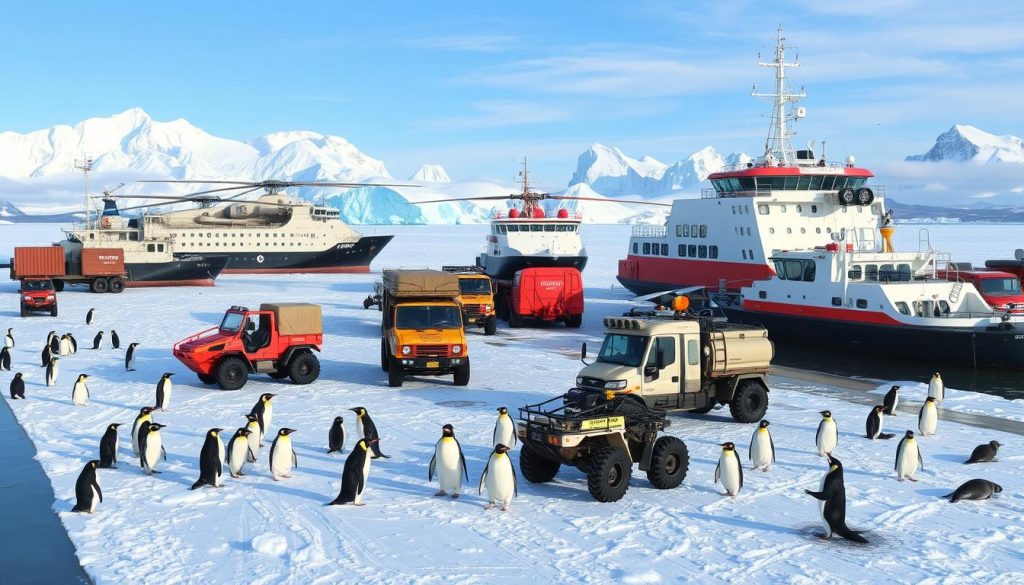
Antarctica’s tough conditions call for special transport means. There are types of transport in Antarctica for different needs. Knowing about these is key for those working in Antarctic transport.
- Air Transport
- Helicopters are crucial for reaching remote places and quick medical help.
- Fixed-wing planes help move people and goods over long distances.
- Maritime Transport
- Icebreakers make it safe to travel through icy seas, helping reach research spots.
- Supply ships bring vital goods, from food to science gear.
- Land Transport
- All-terrain vehicles are vital on tough ground, aiding researchers and visitors.
- Snowmobiles are handy for short trips across snow-covered areas.
Choosing the Right Vehicles and Equipment
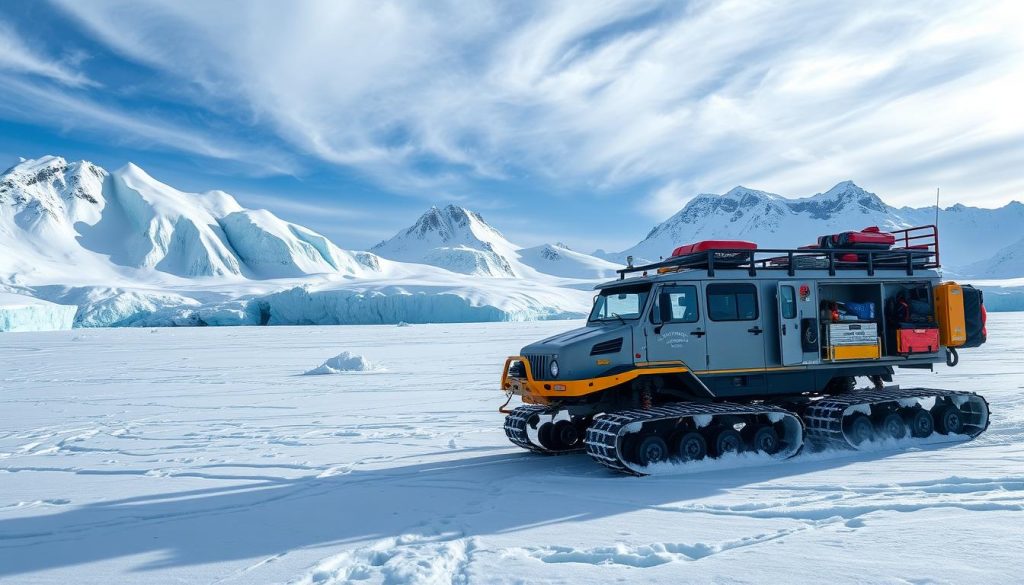
Finding the right vehicles for Antarctic travel is vital to work well in tough conditions. The kind of transport gear you pick greatly affects how reliable and safe your journey will be. It’s important to choose based on how well they move on ice and handle the cold.
Specialised Vehicles for Harsh Conditions
When picking vehicles for Antarctica, being able to adapt is key. The Hägglund BV206, for example, excels on snow and ice, making it perfect for many tasks. Snowmobiles are also great, as they can quickly get through rough areas. Things to think about when choosing a vehicle include:
- How well it works on snow and ice
- The size and weight it can carry
- How much fuel it uses and its impact on nature
- If it’s sturdy enough to avoid frequent repairs
Maintenance and Reliability Factors
Keeping vehicles ready in Antarctica is tough due to the extreme weather. Regular checks and repairs are critical for transport you can rely on. The cold and wet conditions from melting ice can damage gear. To prevent issues, you should:
- Inspect important parts often
- Use materials that don’t rust easily
- Change the oil and check fluids regularly
- Keep an eye on how well the battery works in the cold
By taking good care of your vehicles, you make them safer and they last longer. This supports Antarctic operations well.
Setting Up Operations in Antarctica
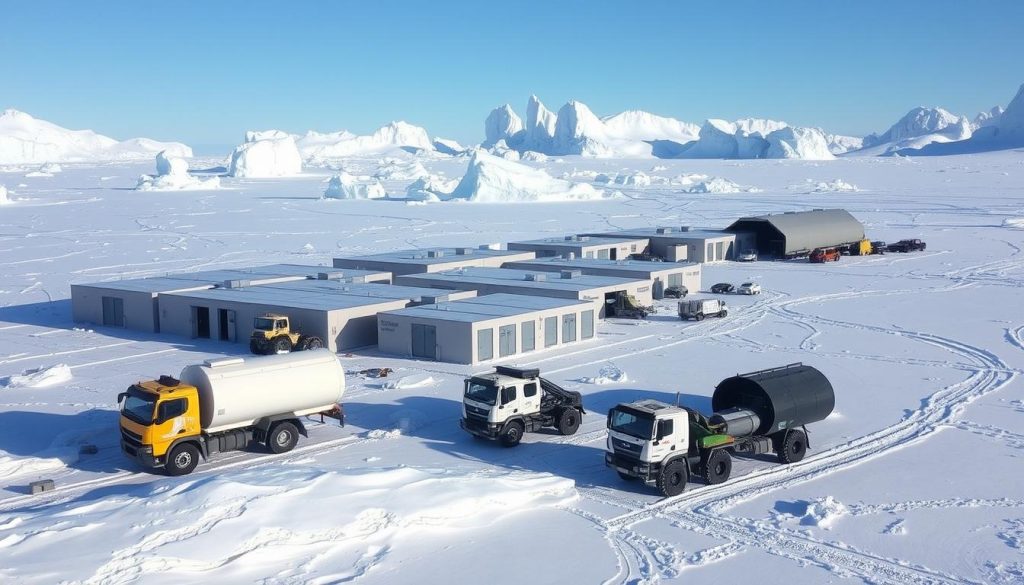
Setting up a successful operation in Antarctica requires lots of careful planning. It’s not just about deciding on a location. It involves making sure you have everything you need. This means creating a solid base for logistics, focusing on location, infrastructure, and resources.
Establishing a Base of Operations
There are several key points to consider when setting up a base:
- Location Selection: Finding the best spot means looking at how easy it is to get to and how close it is to important areas.
- Infrastructure Needs: Building the right facilities is crucial. You need places to store equipment and carry out maintenance.
- Resource Allocation: Having enough supplies and managing them well is essential for keeping the base running smoothly.
- Permitting: Getting all the right permissions is important before you start operations in Antarctica.
Challenges of Operating in Extreme Weather
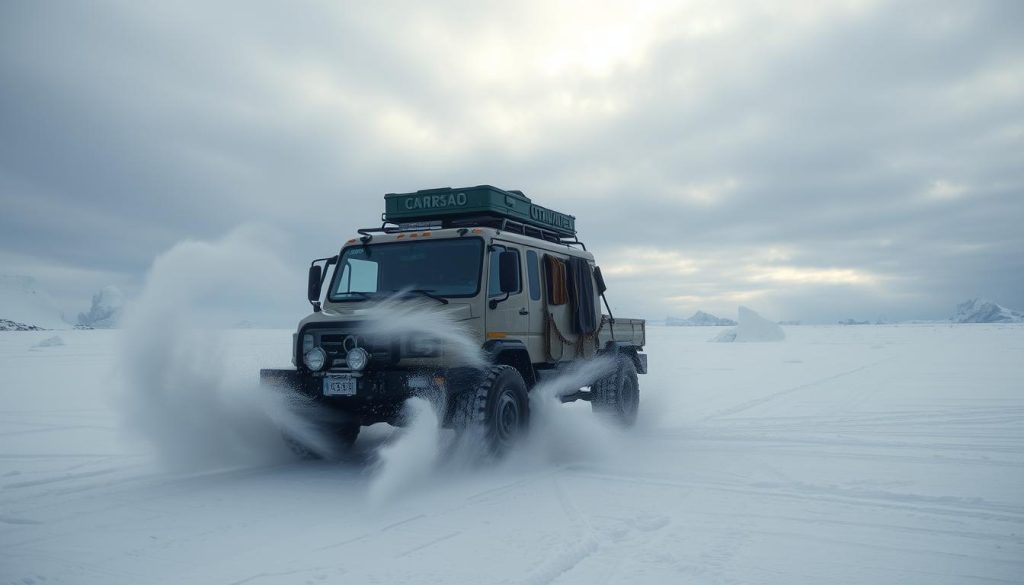
Running a transport business in Antarctica is tough due to extreme weather. The cold, sudden snow, and long nights can stop everything. These conditions make it hard to operate smoothly.
Meticulous planning and strong gear are essential for working in such extreme weather. To manage these challenges, businesses do several things:
- Use vehicles made for ice and wind.
- Have systems to watch the weather closely, staying ready for changes.
- Ensure staff are trained to cope in bad weather, ready for any emergency.
Understanding Antarctica’s unique challenges is crucial. Using snowmobiles and tracked vehicles boosts movement and safety in tough weather.
Success comes to those who stay flexible and put safety first. Learning from past weather problems helps with planning for the future.
Regulatory Compliance and Safety Standards
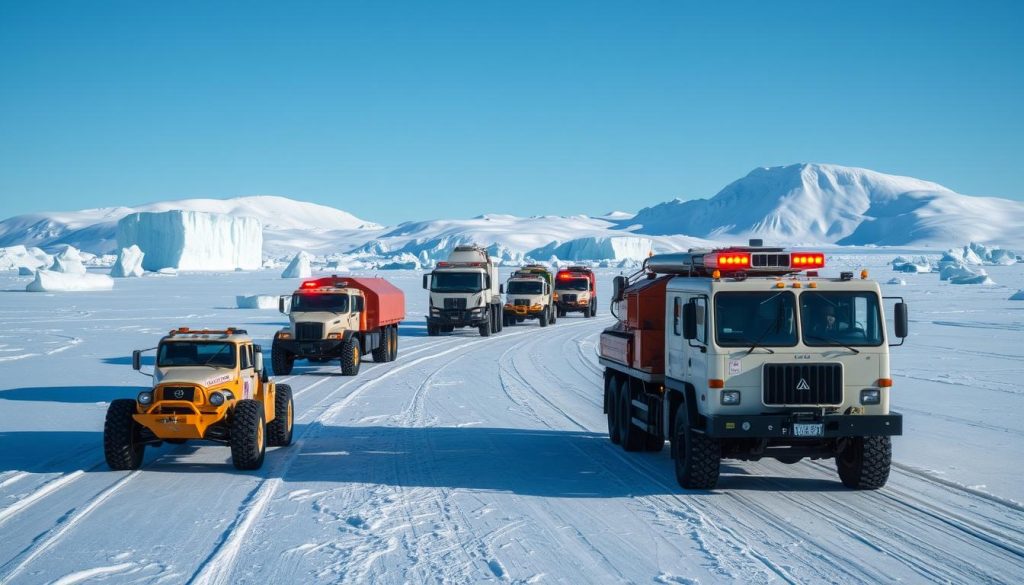
Running a transport business in Antarctica requires strict following of safety rules and transport standards. It’s crucial for protecting workers, the environment, and keeping operations up to standard.
Companies must take care of several important things:
- They must give detailed safety training to all workers. This focuses on the challenges found in Antarctic conditions.
- There must be constant and thorough checks on equipment to keep safety and reliability at their best.
- It’s essential to have all necessary paperwork, including permits, inspections, and protocols, well organised.
It’s vital to keep up with new rules and best practices. Doing so improves both compliance and the safety of operations. A forward-thinking approach helps maintain a safety-focused culture. This doesn’t just meet legal requirements but also raises the level of service for clients.
Hiring Experienced Staff
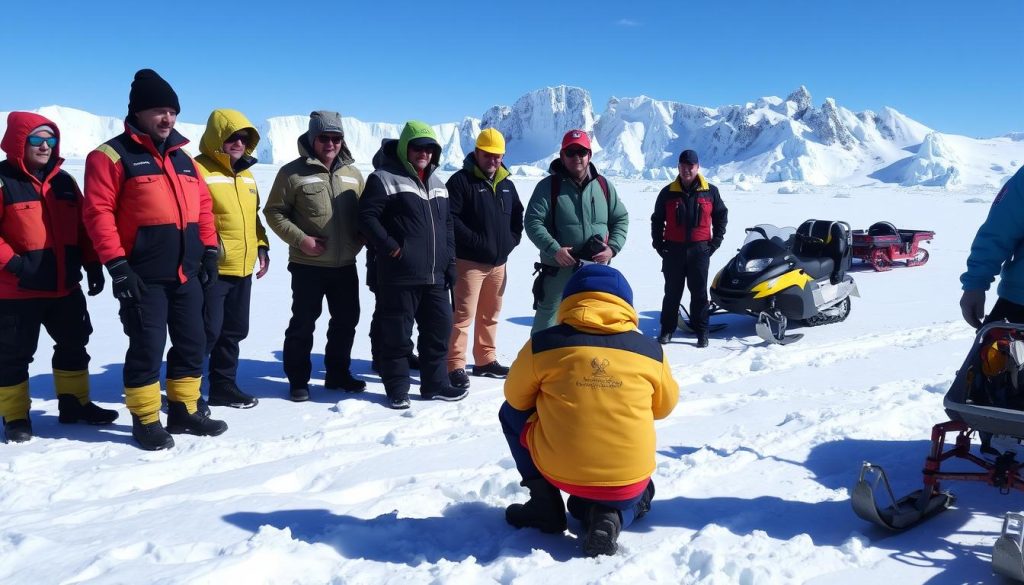
Finding the right people for Antarctic work means looking for those with needed skills and qualifications. The challenges in Antarctica are like no other, needing a team with varied abilities. Knowing the skills for getting around in Antarctica is key to doing well.
Skills and Qualifications Needed
For a skilled Antarctic transport team, certain abilities are necessary, such as:
- Knowing how to navigate the polar regions.
- Being able to use special equipment in tough conditions.
- Having strong skills in solving problems when the weather is extreme.
- Understanding safety rules that are important in Antarctica.
This set of skills helps in forming a capable team for Antarctic tasks. It makes sure the team can work safely and well.
Training for Antarctic Conditions
Good training is vital for preparing Antarctic staff for hard conditions. They need to learn about:
- How to survive in extremely cold weather.
- Providing first aid and responding to emergencies.
- Using equipment made for Antarctic transport.
- Staying up-to-date with safety and work routines.
This training is important for staff to manage unexpected problems in Antarctica. By developing their abilities, companies improve their transport services in this tough area.
Partnerships and Collaborations

Starting strong partnerships in Antarctic transport brings many benefits for companies looking to thrive. Working with groups already in Antarctica lets companies use existing skills and share resources. This is key for success in this special area.
Teaming up with research labs gives crucial weather and logistics info. This boosts how well companies perform in unpredictable conditions. And, working with tourism firms opens up chances to reach more clients needing transport services.
Also, having logistics partners gives access to the right equipment and setup. This shared insight leads to new solutions that suit the tough Antarctic climate.
To build a strong network in Antarctica, companies should follow these steps:
- Look for possible partners among local groups and organizations
- Go to industry events to make connections
- Use online platforms to keep in touch
- Consider teaming up on projects to pool resources and strengths
This way, transport companies can handle the challenges of working in Antarctica more nimbly and efficiently.
Marketing Your Transportation Business
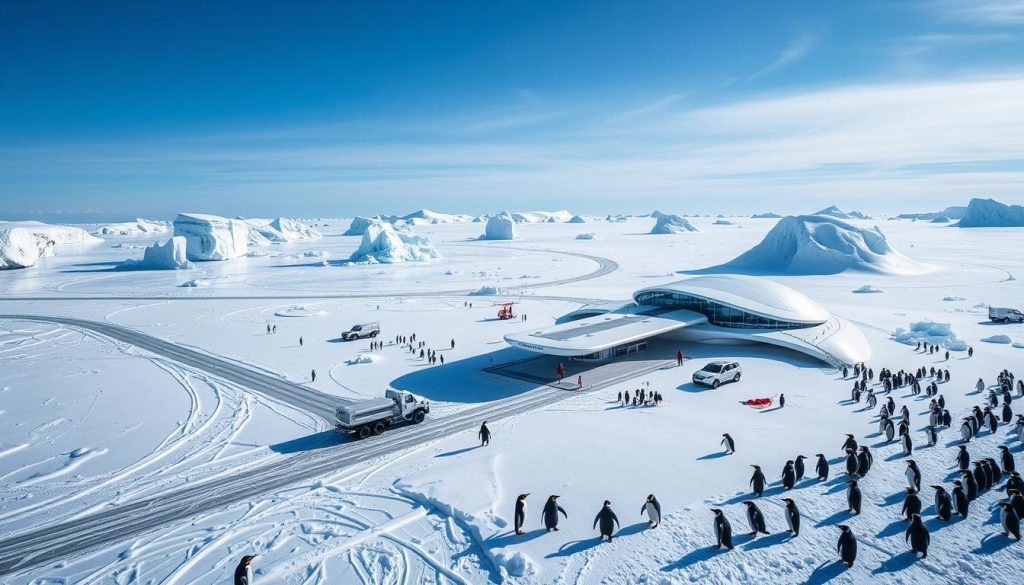
The transport industry is competitive, especially in unique places like Antarctica. A tailored marketing strategy is key. It’s crucial to use effective digital marketing to show your online presence. This way, potential clients see the value of Antarctic services. By using social media and targeted content, you can reach more people.
Creating a Strong Online Presence
Building a strong online presence for Antarctic services includes several steps:
- Make a user-friendly website that shows off services, shares important info, and has client testimonials.
- Use social media to post updates, talk with followers, and show off successful projects or logistics challenges you’ve solved.
- Use SEO strategies to become more visible on search engines, helping potential clients find you more easily.
- Try content marketing through informative blog posts or videos that show your expertise in Antarctic logistics and transport issues.
Financial Planning and Investment Needs
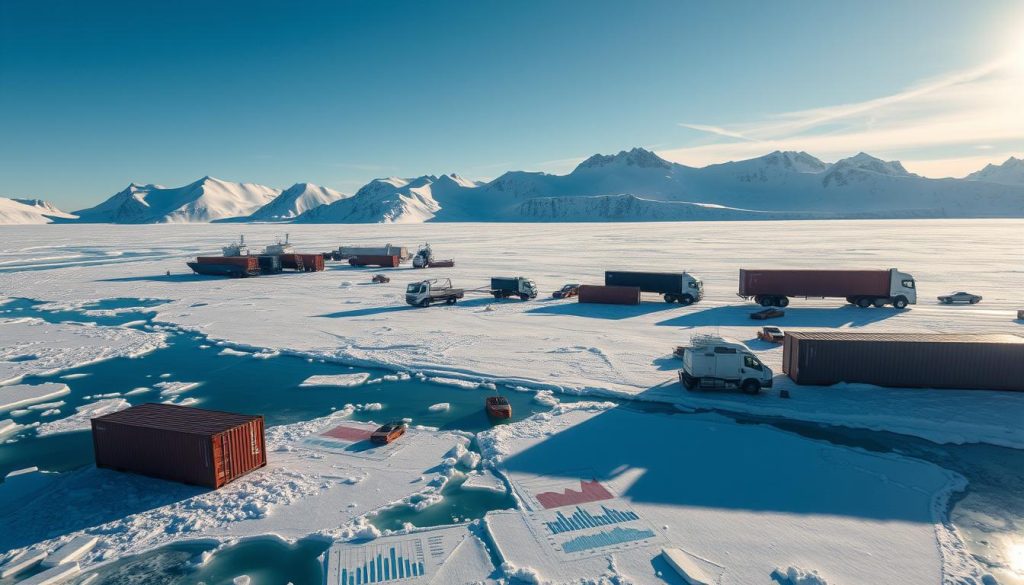
Starting a transport business in Antarctica needs careful financial planning. A solid plan makes sure the business can work well in this special place. Knowing the costs to start, like buying equipment, paying for daily expenses, and wages, is key.
This understanding helps set up a sound financial strategy. It matches the money needs of businesses in Antarctica.
Assessing Startup Costs
First, know the main costs for starting a transport business in Antarctica:
- Equipment costs, including specialised vehicles and maintenance tools.
- Operational costs, covering fuel, insurance, and permits.
- Payroll expenses for skilled staff who are trained to operate in extreme conditions.
Also, finding sources of money to support your plan is vital. Look into government grants, private investors, or partnerships. These can offer the funds needed to start.
Environmental Considerations

Transport businesses in Antarctica face unique challenges. They must think about the local environment in every decision they make. Adopting sustainable transport practices helps protect this delicate region. It also boosts a company’s image with clients and those who have a stake in the business.
Making transport services more eco-friendly can lessen harm to wildlife and natural habitats. Here are vital strategies to follow:
- Using clean energy like solar or wind power for operations.
- Having strict rules to make sure all waste is thrown away properly.
- Using vehicles that don’t use much fuel to lower pollution.
- Checking the environment often to spot and solve any harm quickly.
By following these practices, companies don’t just help save Antarctica’s incredible environment. They also meet the world’s increasing demands for greener transport solutions. Businesses leading in sustainability are seen as pioneers in a market that values the planet’s health.
Future Trends in Antarctic Transportation

The future of Antarctic transport is going to change a lot. New tech and changes in our climate will shape it. Transport in this special place will grow, thanks to new ideas in how to move things around.
Soon, we will see green vehicles made for the ice. These will lower pollution and be safe and dependable. More science and visits will change what we need from these services.
- Advancements in autonomous vehicle technology could transform operational efficiency.
- Increased focus on sustainable practices will likely lead to a rise in hybrid or electric transport options.
- Partnerships between governmental and private sectors may enhance the availability of resources for Antarctic logistics.
As these changes happen, those involved must keep up. They must make sure their services are still top-notch and eco-friendly.
Case Studies of Successful Businesses
Looking into successful Antarctic businesses unveils key lessons about moving goods and people in extreme conditions. One transportation company shines by using vehicles made for tough weather. They keep downtime low through careful maintenance and clever changes to their vehicles. This teaches valuable strategies for those looking to start their own tough ventures.
Another business stands out for its commitment to the environment while staying efficient. They use renewable energy and green tech to surpass legal standards and lead the way in Antarctica. Their story shows the value of being adaptable and eco-aware in business.
Overall, these transport case studies highlight the need for resilience, smart planning, and green practices. By examining their innovative approaches and hurdles, prospective entrepreneurs can learn how to succeed in Antarctica’s challenging conditions.

